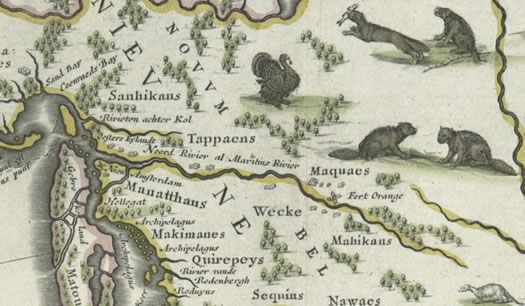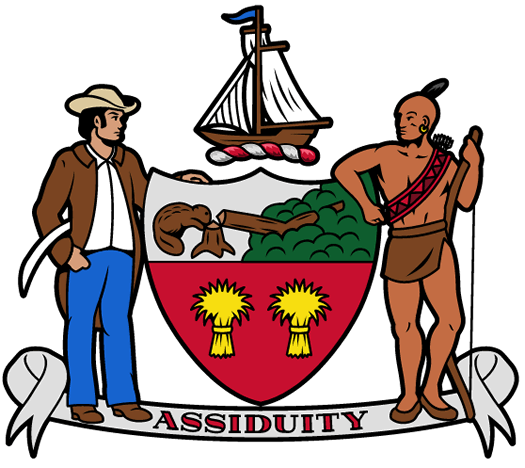Albany, because beavers

North America's largest rodent. And one of the reasons Albany exists. / photo: Steve Hersey via Flickr (CC BY-SA 2.0)
This past Tuesday was International Beaver Day. No, we didn't have marked on our calendar, either. It was a gross oversight on our part.
It's too bad that we missed the day because beavers played an important role in Albany's history. In fact, to some degree, Albany exists because of beavers.
Why the Dutch were here
Henry Hudson had sailed up what's now called the Hudson River looking for a passage to Asia, which, of course, he didn't find. But his voyage still ended up finding something valuable at the time -- a land rich in large, furry rodents. From a New Netherland Institute Institute article about the fur trade:
... The beaver was particularly prized because its fur had a special characteristic: under the long glossy coat was another layer of short, tightly-packed hairs. This layer was made into felt, which produced hats of every description and fashion, of great warmth and quality.
Russia was the first major supplier of beaver and other furs. The decline in its population of furry animals coincided with the French discovery of rich beaver lands in Canada, and with Henry Hudson's charting of the Hudson River. The West India Company founded New Netherland not as a colony for the growth of settlements but as a way to exploit the "soft gold" of the region. Within a few years of Hudson's 1609 voyage, Indians of many tribes were bringing animal pelts along the three major river systems to Dutch trading posts.
Beavers and the fur trade ended up being a vital part of Dutch activity here. And beavers were the subject of intense study by Adriaen van der Donck, one of the most prominent figures in New Amsterdam. Wrote van der Donck: "The beaver is the main foundation and means why or through which this beautiful land was first occupied by people from Europe."

A Dutch map from around 1635. / map via Wikipedia
Van der Donck estimated that at one point 80,000 beaver pelts were exported annually from New Amsterdam. (That number pops up in a few different places, though apparently there's some skepticism that maybe van der Donck was boasting a bit.)
An obligation of beavers
If you skim through early records from Albany you'll frequently encounter mention of beavers, often in regard to them being used as a form of payment. From a 1659 agreement signed at Fort Orange, as detailed in Early Records of the City and County of Albany, and Colony of Resselaerswyck (1656-1675):
Appeared before me Johannes La Montagne in the service of etc, in presence of the afternamed witnesses, Philip Pieterse Schuyler who declares that he has received of Dirck Dirckse Keyser, and taken for safe keeping the following obligations for all which he is attorney.
Rutger Jacobsen, one of 38, and another of 32 beavers.
Jurrian Teunisse [Glasemaeker] an obligation of 22 beavers.
Jan Verbeeck one ditto of 27 beavers.
Pieter Adraensen Soegemackelyck one ditto amounting to 7 beavers.
Anderies Herbertsen, an obligation of 28 beavers.
Jacob Tyssen Vander Heyden, one ditto of 16 1/2 beavers.
Broer Cornelis [Antonissen Van Slyck,] one ditto of 33 1/2 beavers.
Hnderick Bierman, one of 12 beavers.
Geurt Hendrickse [Van Schoonhooven,] one ditto of 3 beavers.
Beverwyck
After the establishment of Fort Orange in the 1620s a community formed just north of the fort as the location became an import node in the network of connections for the fur trade. Thus the community became known as "Beverwijck" in Dutch -- literally, "beaver district." By the 1650s it had become a bustling town, and the Dutch West India Company made the name official.
Beverwijck -- or Beverwyck, as it's Anglicized -- would later get a new name after the English took control in the 1660s: Albany.
Beavers as identity
Signs of the importance of beavers to Albany's early history continued for centuries. One of the three main west-east streams running through Albany was named the Beaverkill (It still exists -- sort of. It runs underground). It ran through Beaver Park -- now called Lincoln Park -- the site of the city's first playground. There's also the Beverwyck neighborhood in Albany, and Beaver Street downtown.

And to this day, a beaver appears on Albany's coat of arms.
And what of the beavers?
The period from the 17th century through the start of the 20th century wasn't the best time to be a beaver in New York. The large scale hunting of the animals for the fur trade, along with habitat loss, almost entirely wiped out beaver populations in the state. And by 1900 the last beavers in New York State were thought to be a population of just 15 animals in the Adirondacks.
Then things started to turn around for beavers. In 1904 the state legislature passed the Beaver Restoration Bill. From a Field and Stream account at the time:
It carries an appropriation of $500, with which the Forest, Fish and Game Commission is authorized to purchase wild beaver and liberate them in the Adirondacks. This measure follows as a natural sequel to the thus far successful effort which the State began three years ago, of restoring the moose and elk to the forests of Northern New York.
The wild beavers were apparently acquired from Yellowstone, and a decade later the Adirondack population was in the thousands. And by the 1980s beaver populations had rebounded around the state -- so much so that they're now considered nuisances in some places. They also became New York's state mammal along the way.
Another sign that beavers are back in New York State: In 2007 a beaver was spotted in the Bronx -- probably the first in New York City in more than two centuries. And in 2010 he was joined by a friend.
____
Furthermore: This paper by Gina Figler, written for the Hudson River Valley Institute, includes a bunch of interesting bits about the history of beavers in the Hudson Valley.
Earlier on AOA: That time whales swam to Albany
Hi there. Comments have been closed for this item. Still have something to say? Contact us.
Comments
The collective noun for beavers is "colony", but "an obligation of beavers" has a nice ring to it...
... said -B on Apr 9, 2015 at 4:21 PM | link
Far out.
... said ethan on Apr 9, 2015 at 4:35 PM | link
Thank you for your interesting article "Albany, Because Beavers" posted on 4/9/15. I live in Florida and was researching my genealogy and clicked on the link to this site as it listed my ancestor, Cornelius Antoissen Van Slyck. Thank you for the background and historical information. I enjoyed it!
Debbie Strauch
... said Debbie Strauch on Apr 21, 2015 at 1:25 PM | link